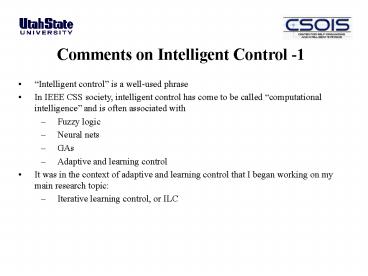Comments on Intelligent Control 1 PowerPoint PPT Presentation
1 / 6
Title: Comments on Intelligent Control 1
1
Comments on Intelligent Control -1
- Intelligent control is a well-used phrase
- In IEEE CSS society, intelligent control has come
to be called computational intelligence and is
often associated with - Fuzzy logic
- Neural nets
- GAs
- Adaptive and learning control
- It was in the context of adaptive and learning
control that I began working on my main research
topic - Iterative learning control, or ILC
2
Comments On Intelligent Control -2
- As I have described, ILC has had a fairly
successful history - Well-established literature of analysis and
design techniques - Well-established practice as evidenced by several
patents related to commercial products - Even a PaperPlaza keyword for ACC/CDC/ISIC/CCA
- If success use, then we can conclude that some
aspects of the promise of intelligent control
have been achieved - NN are ubiquitous (at least FFNNs)
- Any/every undergrad with the Matlab Fuzzy toolbox
can do/does FLC. - And, there have been a large number of ideas on
architectures - Subsumption, behavior-based hierarchical,
behavior-based reinforcement learning,
deliberative/reactive, multi-resolution, 4D/RCS,
etc. - But Are techniques like NN, FLC, or ILC, which
have the word learning in their title,
intelligent? - What is intelligent?
3
Comments On Intelligent Control -3
- From IEEE CSS Defining Intelligent Control,
Report of the Task Force on Intelligent Control,
Antsaklis, Albus, Lemmon, Meystel,
Passino,Saridis, Werbos, IEEE Control Systems
Magazine, pp. 4-5,58-66, June 1994 An
intelligent system - . has the ability to act appropriately in an
uncertain environment, where an appropriate
action is that which increases the probability of
success and success is the achievement of
behavioral subgoals that support the systems
ultimate goal . - .envisioned as emulating human mental faculties
such as adaptation and learning, planning under
large uncertainty, coping with large amounts of
data, etc. . - . aims to attain higher degrees of autonomy and
even setting control goals rather than stressing
the intelligent methodology that achieves those
goals .
4
Example Intelligent Control System
- One version of an intelligent (control) system
(holy grail) - A single machine that can do both of the
following tasks via semantic (verbal) instruction
from a (human) supervisor. - Load a trailer Cooperatively weld a
pipe
5
Whither Intelligent Control? (where are we
today?)
- Are we there yet? Can we do one of those holy
grail applications (harder than the DARPA grand
challenge!)? - In my opinion No.
- Most NN or FLC controllers are better described
as biologically-inspired computational elements. - Primarily compute I/O maps (nonlinear) for use in
feedback control systems. - Do some pattern recognition tasks.
- Self-organize to achieve a functional property.
- Most architectures are best guess engineering
approximations to current state of knowledge
about biological function and its organization.
6
Challenges
- Aside from materials for robotics and perception,
what is needed are better understandings of - Purpose of intelligence (goals)
- Components of intelligence (memory, learning)
- Most learning controllers to date in the
intelligent control field simply perform
parameter adaptation. - Parameter adaptation is not learning.
- Learning requires adaptation at the meta-level
(changes in architectural structure). - Organization of intelligence (models, language,
architecture)
- Remainder of the talk considers algorithms and
organization of intelligence - Single-entity autonomy
- Cooperative Autonomy

